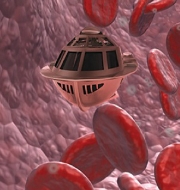Scientists develop world's smallest light powered engine
A group of researchers from University of Cambridge have built the world’s smallest (nanoscale) working engine.
The research team was led by Professor Jeremy Baumberg from the Cavendish Laboratory. They have named the microscopic engine as ANTs (Actuating Nano-Transducers).
Key facts
- The nanoscale engine is just a few billionths of a metre in size and uses light to power itself.
- The prototype engine was made of tiny charged particles of gold. It was bound together with temperature-responsive gel-like polymer called pNIPAM.
- Working: On heating the engine above critical temperature with a laser it stores large amounts of elastic energy in a fraction of a second.
- The elastic energy is mainly produced after the gold particles are bound tightly together with the polymer through intermolecular attraction.
- When it falls below critical temperature, the polymer suddenly absorbs water and expands and the gold particles are pushed rapidly apart like a spring.
- This stored energy generates a propulsive force on a microscopic scale that is a hundred times greater per unit weight than any known motor or muscle.
- Significance: The nanoscale engine could form the basis of future nano-machines. This engine can help to navigate in water, even enter living cells to fight disease or sense the environment around them.
Month: Current Affairs - May, 2016


